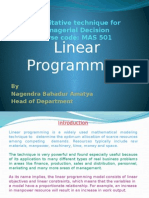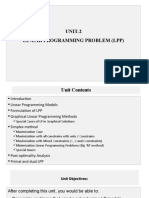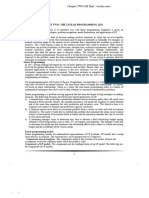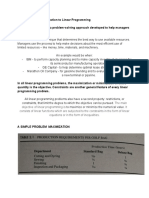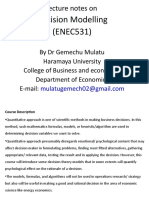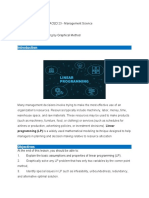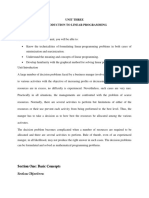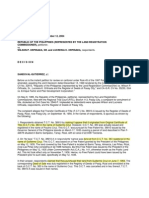Linear Programming
Uploaded by
stephanielimpiosgabrielLinear Programming
Uploaded by
stephanielimpiosgabrielLinear programming (LP) is a widely used mathematical modeling technique designed to help managers
in planning and decision making relative to resource allocation.
PROPERTIES OF LINEAR PROGRAMS
1. One objective function
2. One or more constraints
3. Alternative courses of action
4. Objective function and constraints are linear—proportionality and divisibility
5. Certainty 6. Divisibility
7. Nonnegative variables
Explanation: The technique is very powerful and found especially useful because of its application to
many different types of real business problems in areas like finance, production, sales and distribution,
personnel, marketing, and many more areas of management.
As its name implies, the linear programming model consists of linear objectives and linear objectives,
and linear constraints, which means that the variables in a model have a proportionate relationship. For
example, an increase in manpower resource will resource in an increase in work output.
Formulation of linear programming is the representation of problem situation in a mathematical form. It
involves well defined decision variables, with an objective function and set of constraints.
Decision variables- completely describe the actual decisions to be made.
Objective Function- is the function of the decision variables that the decision maker wants to maximize
(revenue or profit) or minimize (costs).
Constraints – restrictions that limit the degree to which we can pursue our objective.
Decision variable
T – number of tables to be produced per week
C – number of chairs to be produced per week
Objective function
Maximize profit = $70T + $50C
Mathematical constraints to describe the two constraints
One general relationship is that the amount of a resource used is to be less than or equal to the amount
of the resource available.
(4 hours per table) (number of tables produced)
+ (3 hours per chair) (Number of chairs produced)
Constraints are
1. The hours of carpentry time used cannot exceed 240 hours per week.
Carpentry time used ≤ Carpentry time available
4T + 3C ≤ 240 (hours of carpentry time)
2. The hours of painting and varnishing time used cannot exceed 100 hours per week.
Painting and varnishing time used ≤ painting and varnishing time available
2T + 1C ≤ 100 (hours of painting and varnishing time)
Unboundedness Sometimes a linear program will not have a finite solution. This means that in a
maximization problem, for example, one or more solution variables, and the profit, can be made
infinitely large without violating any constraints
Redundancy The presence of redundant constraints is another common situation that occurs in large LP
formulations. Redundancy causes no major difficulties in solving LP problems graphically, but you should
be able to identify its occurrence. A redundant constraint is simply one that does not affect the feasible
solution region. In other words, other constraints may be more binding or restrictive than the redundant
constraint.
Alternate Optimal Solutions An LP problem may, on occasion, have two or more alternate optimal
solutions. Graphically, this is the case when the objective function’s isoprofit or isocost line runs
perfectly parallel to one of the problem’s constraints—in other words, when they have the same slope.
You might also like
- Linear Programming Basic Concepts and Graphical SolutionsNo ratings yetLinear Programming Basic Concepts and Graphical Solutions7 pages
- Linear Programming Models: Graphical and Computer Methods: To Accompany by Render, Stair, and HannaNo ratings yetLinear Programming Models: Graphical and Computer Methods: To Accompany by Render, Stair, and Hanna71 pages
- 1.2 Linear Programming: Model Formulation and Graphical SolutionNo ratings yet1.2 Linear Programming: Model Formulation and Graphical Solution10 pages
- Linear Programming Models: Graphical and Computer MethodsNo ratings yetLinear Programming Models: Graphical and Computer Methods49 pages
- Quantitative Analysis For Management Decisions (MBA 662)No ratings yetQuantitative Analysis For Management Decisions (MBA 662)50 pages
- LPPGraphicalMethod 062019ppt 2019 07 22 16 38 52No ratings yetLPPGraphicalMethod 062019ppt 2019 07 22 16 38 5255 pages
- Materi 2 - Linier Programing Metode Grafik - 18 April 2025 - 20 Syawal 1446No ratings yetMateri 2 - Linier Programing Metode Grafik - 18 April 2025 - 20 Syawal 144615 pages
- Linear Programming Models: Graphical and Computer Methods: To AccompanyNo ratings yetLinear Programming Models: Graphical and Computer Methods: To Accompany92 pages
- Linear Programming Models: Graphical and Computer Methods: To AccompanyNo ratings yetLinear Programming Models: Graphical and Computer Methods: To Accompany87 pages
- Linear Programming Graphical Methods: Presented By:-Ishant Soni Chitranshu KhareNo ratings yetLinear Programming Graphical Methods: Presented By:-Ishant Soni Chitranshu Khare8 pages
- A History of Science and Technology in The PhilippinesNo ratings yetA History of Science and Technology in The Philippines1 page
- Foundations of Library and Information Science 4th Edition Richard E. Rubin download pdf100% (1)Foundations of Library and Information Science 4th Edition Richard E. Rubin download pdf81 pages
- Calculation of Forces On POT / PTFE Bearings-24.60M SPAN & 10.50M DECKNo ratings yetCalculation of Forces On POT / PTFE Bearings-24.60M SPAN & 10.50M DECK6 pages
- Gradient-Based Feature Extraction From Raw Bayer Pattern ImagesNo ratings yetGradient-Based Feature Extraction From Raw Bayer Pattern Images12 pages
- Adherence, Flexibility, and Outcome in PsychodynamicNo ratings yetAdherence, Flexibility, and Outcome in Psychodynamic11 pages
- A Study On Customer Perception Towards HDFC LimitedNo ratings yetA Study On Customer Perception Towards HDFC Limited13 pages
- CS 1000/CS 3000 HIS Operation: IM 33S02C10-01E 13th EditionNo ratings yetCS 1000/CS 3000 HIS Operation: IM 33S02C10-01E 13th Edition84 pages
- Mechanical Sample Book PDF For Gate Exam PDFNo ratings yetMechanical Sample Book PDF For Gate Exam PDF28 pages
- The Rotordynamics Analysis of The Washing Machine Shaft Supported by Passive MagneticNo ratings yetThe Rotordynamics Analysis of The Washing Machine Shaft Supported by Passive Magnetic22 pages
- Sennheiser Rs 175 Manuale Utente (English Version)No ratings yetSennheiser Rs 175 Manuale Utente (English Version)36 pages
- Activity 1: K-W-L Chart What I Know What I Want To Know What I LearnedNo ratings yetActivity 1: K-W-L Chart What I Know What I Want To Know What I Learned5 pages
- Draft Old Oak and Park Royal Opportunity Area Planning FrameworkNo ratings yetDraft Old Oak and Park Royal Opportunity Area Planning Framework130 pages















